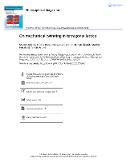On mechanical twinning in tetragonal lattice

Author
Zelený, Martin
Ostapovets, Andriy
Fridrich, Lucius
Šesták, Petr
Heczko, Martin
Kruml, Tomas
Publication date
2023Published in
Philosophical MagazineVolume / Issue
103 (2)ISBN / ISSN
ISSN: 1478-6435Metadata
Show full item recordCollections
This publication has a published version with DOI 10.1080/14786435.2022.2135037
Abstract
The theory of mechanical twinning is revisited for the case of face-centred tetragonal lattices. The motivation is an imprecision in the determination of twinning shear vector magnitude, which occurs repeatedly in the literature. The magnitude of this vector describing the mutual shear of two adjacent crystallographic planes in the process of twin formation is a function of the tetragonality of the lattice c/a. Therefore, we introduce the c/a-dependent factor f which has to be applied to the magnitude of shearing vector < 112] instead of the commonly use factor 1/6, which is correct only for perfect cubic lattices. The theory is verified by ab initio calculations of the generalised planar fault energy curves for three tetragonal materials: the nonmodulated martensite phase of Ni(2)FeGa magnetic shape memory alloy, gamma-TiAl intermetallic and pure In. Moreover, the calculations show that the additional modification of shear vector is caused by structural optimisation due to short-range interactions in the vicinity of twin interface, especially for lattices with large deviation of c/a from 1. Such modification cannot be simply predicted from the lattice geometry.
Keywords
Twinning, tetragonal lattice, phase transformations, intermetallic compounds
Permanent link
https://hdl.handle.net/20.500.14178/2348License
Full text of this result is licensed under: Creative Commons Uveďte původ-Neužívejte dílo komerčně-Nezpracovávejte 4.0 International



